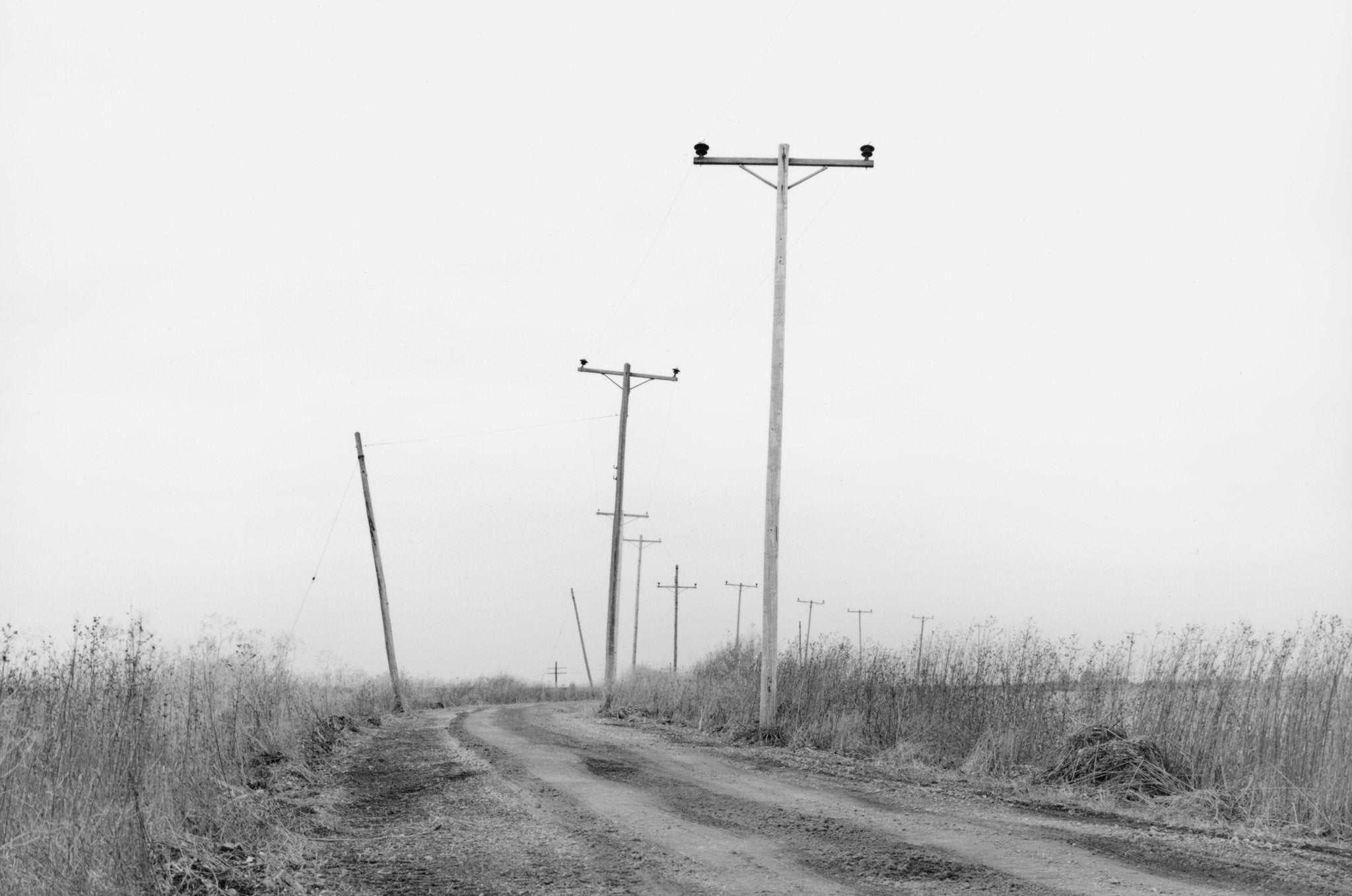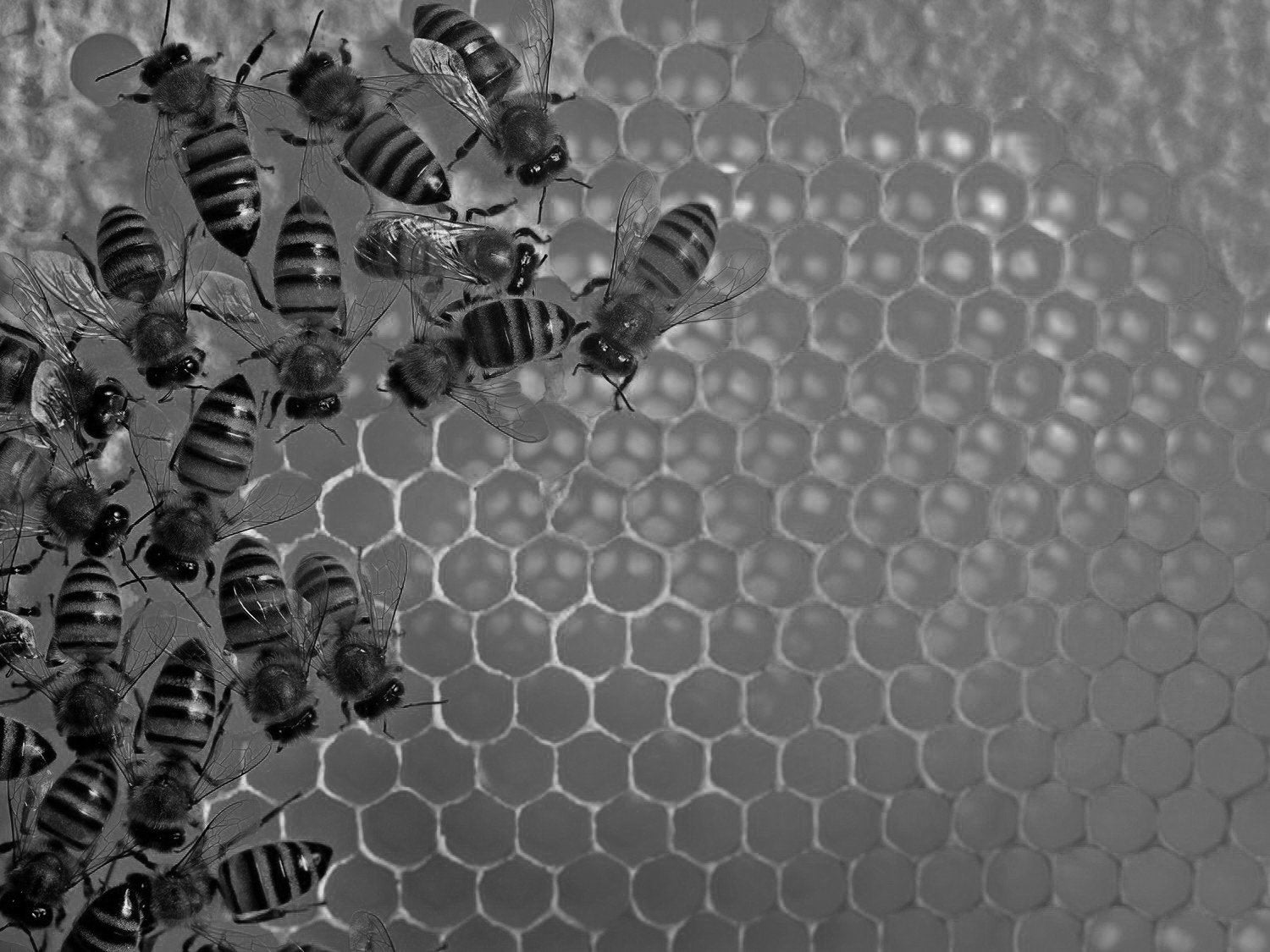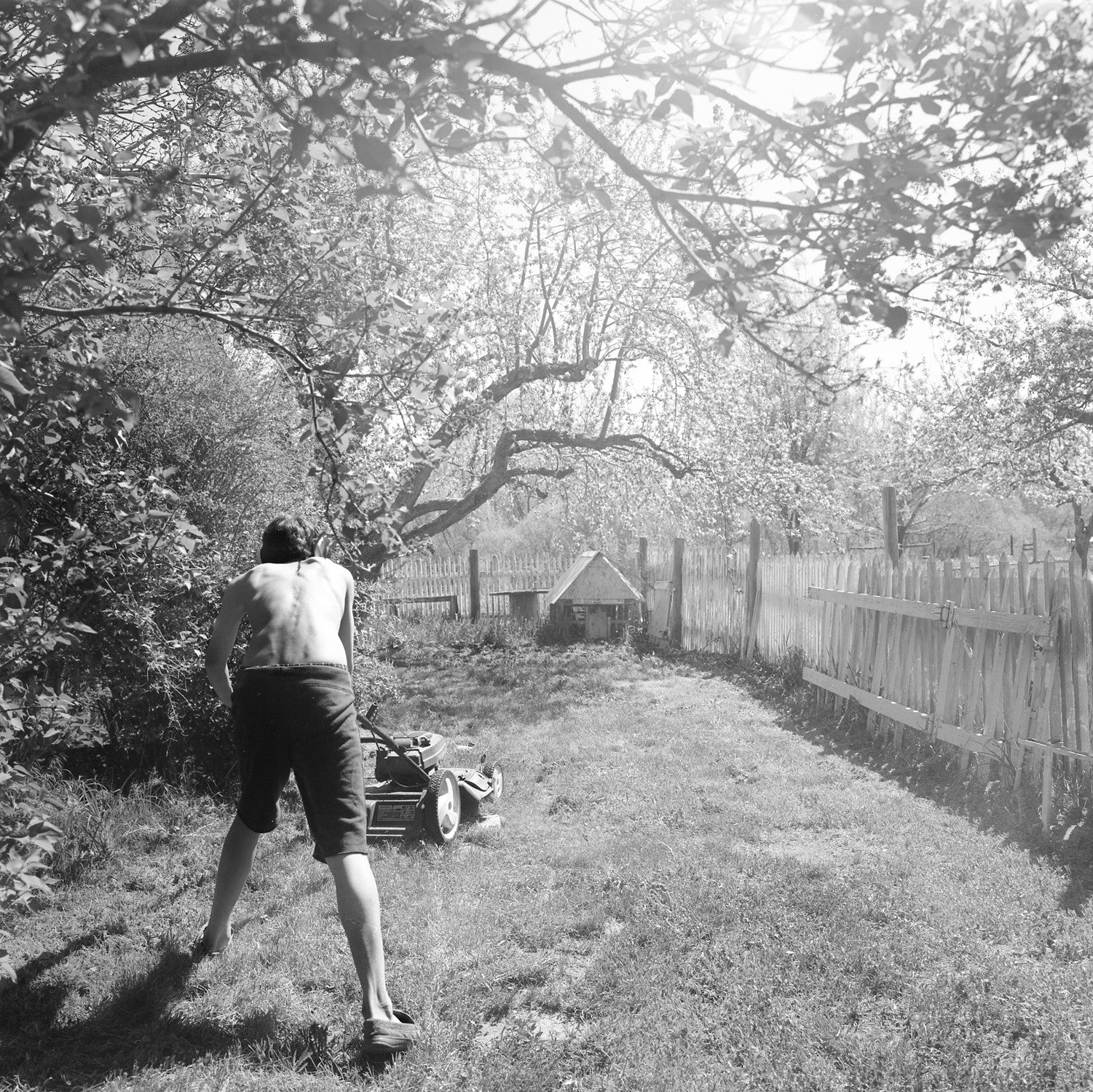
The spirit of the case
“[T]he facts of the case are not the spirit of the case, and sometimes the spirit is primary,” writes Lewis Hyde in an essay on Thoreau called “Prophetic Excursions,” and it seems a simple, even obvious, thing to state. But it’s a notion that took me a long time to fully internalize and embrace with respect to photography.
My hangup with photographic facts came to a fine point mid-way through my MFA thesis project, for which I was making pictures along the abandoned right-of-way of the Illinois Traction (IT) railroad. I was travelling the line with my father – a lifelong railfan who is making a scale model of that railroad in his basement – and getting background from members of the Illinois Traction Society, a preservation group. I felt a duty of veracity to these people. Add to this the fact that I am very much my father’s son; he is an engineer (alas, not of the locomotive-driving sort) whose nature and training are given to the objective sighting and recounting of evidence.
Then one day we were looking at the in-progress model, and I asked dad about my favorite part of the IT right-of-way, an elegant s-curve between Bement and Milmine that is miraculously still marked by standing electrical poles. Well, it turns out that a quarter mile of gentle sinuous arc in the real world ceases to exist when the several miles between towns are reduced to just a foot or two on the model. This was a bit of Eureka moment for me: if my dad, who is very precise and exacting in every aspect of model-building, was willing to give up that beautiful curve for the overall reality of the model, then I could probably loosen up on the “realism” in my project a little bit, too.
To that point, I wish maybe I’d read Leon Wieseltier’s assessment of Dürer’s “The Great Piece of Turf” years ago, especially this part where he wrote: “Realism in art is not like realism elsewhere. In art, realism, too, is an accomplishment of the imagination. What is imagined is the world as it really is; or the world as it would appear if it were totally visible, or if we were totally able to see it.” With respect to Dürer, “The verisimilitude with which he rendered the dense scene – the almost microscopic clarity of the soaring or languid blades of grass in this humble thicket – was not the mere record of a man’s optical observations. The uncanny likeness is a fantasy of the actual. As such, it is a lesson in looking; and also in the collapse of the dichotomy between the ideal and the real. They are barren without each other.”
Not the mere record of a man’s optical observations. Rilke says something very similar of Cezanne: “He turned to nature and knew how to swallow back his love for every apple and put it to rest in the painted apple forever. Can you imagine what this is like, and what it’s like to experience this through him?” I can indeed imagine what that’s like, particularly when I look at my dad’s model; and I aspire to the same, in which, Rilke says, “the love is so thoroughly used up in the action of making that there is no residue.”
Leave it to the practical and economical Wright Morris to jam all this sentiment down into a lovely aphorism: “Only fiction will accommodate the facts of life.”
But so how exactly can fiction accommodate the facts of life? One answer comes from a phrase my dad used while showing the model to a friend of mine; when he was explaining the real-world specifics of towns and grain elevators, lakes and bridges, curves and grades – whether actually represented in the model or not – he said that the finished model will be the result of “selective compression.” Which concept was of course implicit in my earlier revelation about the s-curve on the model. But this specific language prompted another Eureka moment, as it gave me new insight into a couple things I’d been reading.
Instead of the word “compression,” Flannery O’Connor talks of “distortion,” but “not the kind . . . that destroys; it is the kind that reveals, or should reveal.” And it’s not unusual to feel a sense of revelation in the presence of a thoughtful model, particularly one that reproduces the surface of the earth. I easily become entranced by just a map or a globe, and a scale model feels downright mysterious. Indeed, O’Connor goes on to say, “The type of mind that can understand good fiction is not necessarily the educated mind, but it is at all times the kind of mind that is willing to have its sense of mystery deepened by contact with reality, and its sense of reality deepened by contact with mystery. Fiction should be both canny and uncanny.” I find that last sentence remarkable; I can say with certainty that every photobook that I love strikes me as both canny and uncanny.
For TS Eliot, compression and/or distortion – he calls it “pressure” – is crucial for the transition to the uncanny, and it’s expressly active: “[I]t is not the ‘greatness,’ the intensity, of the emotions, the components, but the intensity of the artistic process, the pressure, so to speak, under which the fusion takes place, that counts.” Whereas the ordinary person puts intense feelings “to sleep, or trims down his feeling to fit the business world; the artist keeps it alive by his ability to intensify the world to his emotions.” And finally, the poem is both “a concentration, and a new thing resulting from the concentration.” (italics mine)
I’m getting overly quotey, but here’s Lionel Trilling, in an essay titled “Anna Karenina,” to really hammer home my point:
This quality of lifelikeness, which, among all novelists, he possesses to the highest degree, does not make Tolstoi the greatest of novelists. Great as he is, there are effects which are to be gained by conscious manipulation and distortion, by plot and design, by sheer romancing, which he with his characteristic method cannot manage; there are kinds of illumination and delight which Tolstoi cannot give us but which Dickens, Dostoevski, and James can . . . It is against his work that we measure the degree of distortion, exaggeration, and understatement which other novelists use – and of course quite legitimately use – to gain their effects.
A scale model is by its essence a conscious manipulation of the world, and a new thing in the world. My father, in his model-building, does not consider himself an artist; he’s more likely to be proud of the model as an engineering achievement. Which, believe you me, it already is even in its half-finished stage. And yet, I can’t help believing that the intellectual work that went into – that still goes into – the creation of the model is akin to Dürer’s and Cezanne’s. Dad’s painstaking recreation of the bridge over Lake Decatur – his sheer romancing of it – is a lesson in looking and a collapse between the ideal and the real; to my mind, he swallowed back his love for every workaday Midwestern grain elevator and put it to rest in his handmade replica of the long-gone elevator that stood at the Myron Station between Monticello and Bement.
This “yearning of a model-maker to analogize the world” is recognized by Michael Chabon in his lovely essay “Wes Anderson’s Worlds.” Chabon notes that Anderson’s films are aptly compared to Cornell’s assemblages, but not for the contents of either. Rather, it’s the box that’s the whole game: “It makes explicit, in plain, handcrafted wood and glass, the yearning of a model-maker to analogize the world, and at the same time it frankly emphasizes the limitations, the confines, of his or her ability to do so.”
Chabon says that “the things in Anderson’s films that recall Cornell’s boxes” are
often cited as evidence of his work’s “artificiality,” at times with the implication, simple-minded and profoundly mistaken, that a high degree of artifice is somehow inimical to seriousness, to honest emotion, to so-called authenticity. All movies, of course, are equally artificial; it’s just that some are more honest about it than others. In this important sense, the hand-built, model-kit artifice on display behind the pane of an Anderson box is a guarantor of authenticity; indeed I would argue that artifice, openly expressed, is the only true “authenticity” an artist can lay claim to.
Anderson’s films, like the boxes of Cornell or the novels of Nabokov, understand and demonstrate that the magic of art, which renders beauty out of brokenness, disappointment, failure, decay, even ugliness and violence – is authentic only to the degree that it attempts to conceal neither the bleak facts nor the tricks employed in pulling off the presto change-o. It is honest only to the degree that it builds its precise and inescapable box around its maker’s x:y scale version of the world.
We’re back to that collapse between the real and the ideal, but with the added twist that, according to Chabon, to entirely obfuscate the idealized part would rise to the level of dishonesty. Can we liken artifice to a kind of compression? Probably not entirely: the pressure or distortion encouraged by Eliot and O’Connor doesn’t suffer the same fate as artifice – compression is never on its own mistaken for inauthenticity. Perhaps artifice is some subset of compression, one of many methods of concentrating the world. It’s just a tricky one to pull off. But the benefits, in my dad’s models or Wes Anderson’s movies, are substantial. And my lesson was some subset of that: even if you don’t embrace full-on artifice in the finished work, you must realize that artifice (or “idealization,” the “uncanny,” the “spirit of the case,” however you want to call it) will be inherent in anything you make that’s at all interesting.
Indeed, in my desire for strict realism in my thesis project, I came close to succumbing to the “false promise of photography,” as Judy Fiskin calls it in her essay “Borges, Stryker, Evans: The Sorrows of Representation.” She recounts a Borges story that is
full of references to photography because, of all the representational arts, it seems to hold out the best hope for the possibility of a total representation. It inspires an extra measure of belief because its inherent superrealism conceals the omissions and abstractions by which we recognize the fictions of art. And, through its combination of fantastic detail and concealed compressions, it can supersede reality in the wealth of experience it seems to offer.
So the compression inherent in a photograph is concealed, and that fact keeps us from comprehending the fiction that is so easily seen in other forms of art. And that’s the setup for Fiskin to discuss the relative photographic successes of Walker Evans and his FSA boss Roy Stryker:
[Evans] succeeded where Stryker failed because Evans settled for art. Stryker succumbed to the false promise of photography, strove to represent literally the world’s profusion, and inevitably produced a body of work whose scope seems puny compared to its model. Evans, also working through accumulation, but in a much more condensed, allusive, and circular manner, succeeded in eliciting what Stryker so much wanted to express: a sense of the true multiplicity of the world.
That’s a remarkable assertion: that Evans “settled for art.” It makes it sound so easy to let go of the world’s profusion, when of course it’s anything but, especially with a camera in your hands. And yet, we must undertake the work to condense experience into the model that makes the chaotic profusion “puny” by comparison. I’ll end with a last thought from Fiskin: “The more accurate the representation, the more sharply felt is the absence of the represented subject. Evans knew: representation cannot keep its promises.”



